
The Free Press

When James Hilton was a high school sophomore in Darien, Connecticut, his parents sent him to a psychiatrist because of the many problems he was having at school: He struggled to do his assignments, and then forgot to turn them in. He played the guitar in the school band, but it was agony to sit still for practice.
“I rarely did my homework. I failed French freshman year,” he told me recently. “It was like a class clown kind of thing.”
The psychiatrist diagnosed attention deficit hyperactivity disorder—ADHD—and prescribed a popular drug that, for almost three decades, has helped people who can’t sit still and focus: Adderall, a stimulant composed of two amphetamines.
The drug changed James’ life.
Adderall became his “morning cup of coffee,” he told me. But it also became much more. Adderall helped him do the things he loved: playing the guitar, working out, reading, getting outside, and having great discussions with friends. His grades went up; he sat still in class; he turned in his homework on time; he became captain of the crew team.
“Taking Adderall made me realize I wasn’t stupid,” he told me. “I started taking this medicine, and it was like, ‘Holy shit, I actually understand everything.’ ”
He was accepted to Columbia University, where he kept up a daily routine. He’d start his day with an Adderall at breakfast, then go to his lectures and rowing practice; then he’d take another Adderall, do his homework, and go to sleep. Now a rising senior majoring in environmental biology, James rows crew (his team won the Head of the Charles Regatta in 2018), and writes and records his own music.
Over the past few months, however, things have changed. James has been waking up around 1:00 p.m. “I don’t really ever start my day,” he says. He has to make to-do lists to keep himself on track and to remember basic chores like laundry and homework.
The cause is the nationwide shortage of Adderall, which the FDA declared about eight months ago. Without his daily pills, James is unraveling: “I no longer have the self-motivating chemicals to go outside,” he told me. “I’m definitely feeling really down.”
The Adderall shortage has highlighted the central role the stimulant plays in many American lives—more than 19 million children and adults are estimated to have Adderall prescriptions. Some, like James, are desperately searching for the pill they credit with turning them into productive people. Others, mostly in their twenties and thirties, who have been taking Adderall since they were kids, are questioning if they were just normal, restless teens who were given a quick fix—and wound up tethered to the pharmaceutical industry. They now wonder who they would be without it, and are also afraid to find out.
Then there are those who are misusing the drug—they either had a prescription that ran out long ago, or never had one and are obtaining it from friends or the black market. According to a 2020 national survey, more than 5 million people are estimated to misuse prescription stimulants. In the face of the shortage, they are occasionally trying alternatives such as psychedelic mushrooms. But many are also buying counterfeit versions of Adderall that the DEA warned might contain “potentially life-threatening hidden ingredients, such as fentanyl or methamphetamine.” The threat is real. Last year, two students at Ohio State died after taking fake Adderall laced with fentanyl.
Adderall itself does not have as deadly a profile as opioid drugs—although it can be fatal if misused—so it has attracted less interest from officials. But the shortage, and the reasons for it, has focused the attention of the federal government on the online world where ADHD is easily diagnosed, and prescriptions of stimulants to treat it are given almost instantly. Recently there has been a law enforcement crackdown on these portals, plus enhanced warnings from the U.S. Food and Drug Administration about the dangers of the abuse of Adderall and other ADHD drugs.
A new FDA advisory states that most people who “misuse and abuse” these drugs usually get them from friends and family members who have prescriptions. The agency also warns that people who don’t have ADHD, but take Adderall to enhance studying or partying, run the risk of addiction.
There are a host of causes of the Adderall shortage. One is manufacturing delays from Teva, a major producer of the amphetamine mixed salts that comprise the drug’s main ingredients. Another is that Adderall is a controlled substance, and its production is regulated by the U.S. Drug Enforcement Administration. Having too much of any controlled substance floating around makes the DEA nervous, so it caps the amount of amphetamine made available to pharmaceutical manufacturers each year. During the shortage, both manufacturers and the government have pointed fingers at each other.
Another reason for the shortage is a dramatic rise in Adderall prescriptions in recent years, thanks to online medical providers willing to prescribe the drug quickly, especially during the Covid-19 lockdowns. From 2020 to 2021, there was over a 10 percent increase in prescriptions among males aged 25 to 44 and females aged 15 to 44, as people found working from home can pose more distractions than a gray cubicle. For American women between the ages of 20 and 24, Adderall prescriptions spiked a remarkable 20 percent between 2020 and 2021.
Adderall was approved by the FDA in 1996 to treat restless kids, and millions of dollars were spent to market it to physicians. It worked, with ADHD diagnoses and Adderall prescriptions increasing in tandem. (A non-amphetamine stimulant, Ritalin, has been approved to treat children with behavioral problems since 1961.) According to the CDC, 3 to 5 percent of American children were believed to have ADHD in the 1990s. Today that figure is almost 11 percent.
Adderall is no longer thought of as just a pediatric drug, something for restless children—mostly boys—to take until they outgrow their ADHD. There is increasing recognition that for many, ADHD is a lifetime diagnosis.
Social media, perhaps the greatest cause of our modern distractibility, has become a major driver in the lucrative business of treating it. Many TikTok videos list ways to get an Adderall prescription online and how to self-diagnose ADHD (three symptoms cited by the CDC include being “easily distracted,” acting as if “driven by a motor,” and having “trouble organizing tasks and activities”). Studies have found that watching TikTok increases self-diagnosis for ADHD. The hashtag #ADHD has 14 billion views, and #ADHDdiagnosis has 46.1 million views.
Last year the company Cerebral, which provides online therapy and medication, was the third largest advertiser on TikTok after Amazon and HBO. After filling out a questionnaire, followed by a 30-minute video call with a “licensed prescriber,” Cerebral can provide an ADHD diagnosis and prescription for medication.
I took the eight-minute questionnaire earlier this year, and the questions included “How often do you have difficulty keeping your attention when you are doing boring or repetitive work?” and “How often do you find yourself talking too much when you are in social situations?” My results told me I have ADHD, bipolar disorder, moderate anxiety, and moderate depression. (As best I know, I don’t.)
Last month, however, it was reported that both the DEA and the Department of Justice are investigating Cerebral for possible violations of the Controlled Substances Act. As Fierce Healthcare reports, Cerebral, valued at $4.8 billion, launched in January 2020 and was perfectly positioned to prescribe powerful mental health drugs for people stuck at home, feeling desperate, and unable to see their regular doctors. The company is now no longer prescribing Adderall.
Dr. David Goodman is an assistant professor in the Department of Psychiatry and Behavioral Sciences at Johns Hopkins School of Medicine, with a clinical focus on treating adults with ADHD. He says the shortage of Adderall has created havoc for many of his patients. “If they go a few weeks without medication, there are huge changes in their lives.” He says he’s had patients who have lost jobs, whose marriages are in distress, who are so distracted they are running red lights. “People get embarrassed by their own behavior,” he said. “It’s humiliating.”
He compares having ADHD to blurred vision. “You could spend your life with it, but think how much more you could get done with glasses. The medicine is the glasses.”
There is no brain scan, no blood test for ADHD. A diagnosis at his clinic comes after a comprehensive clinical evaluation requiring a complete patient history. Goodman says more than 70 percent of his patients have another psychiatric disorder—things like bipolar disorder or panic disorder. He fears that quick online prescribers, by failing to diagnose and treat properly, can make complex medical situations worse.
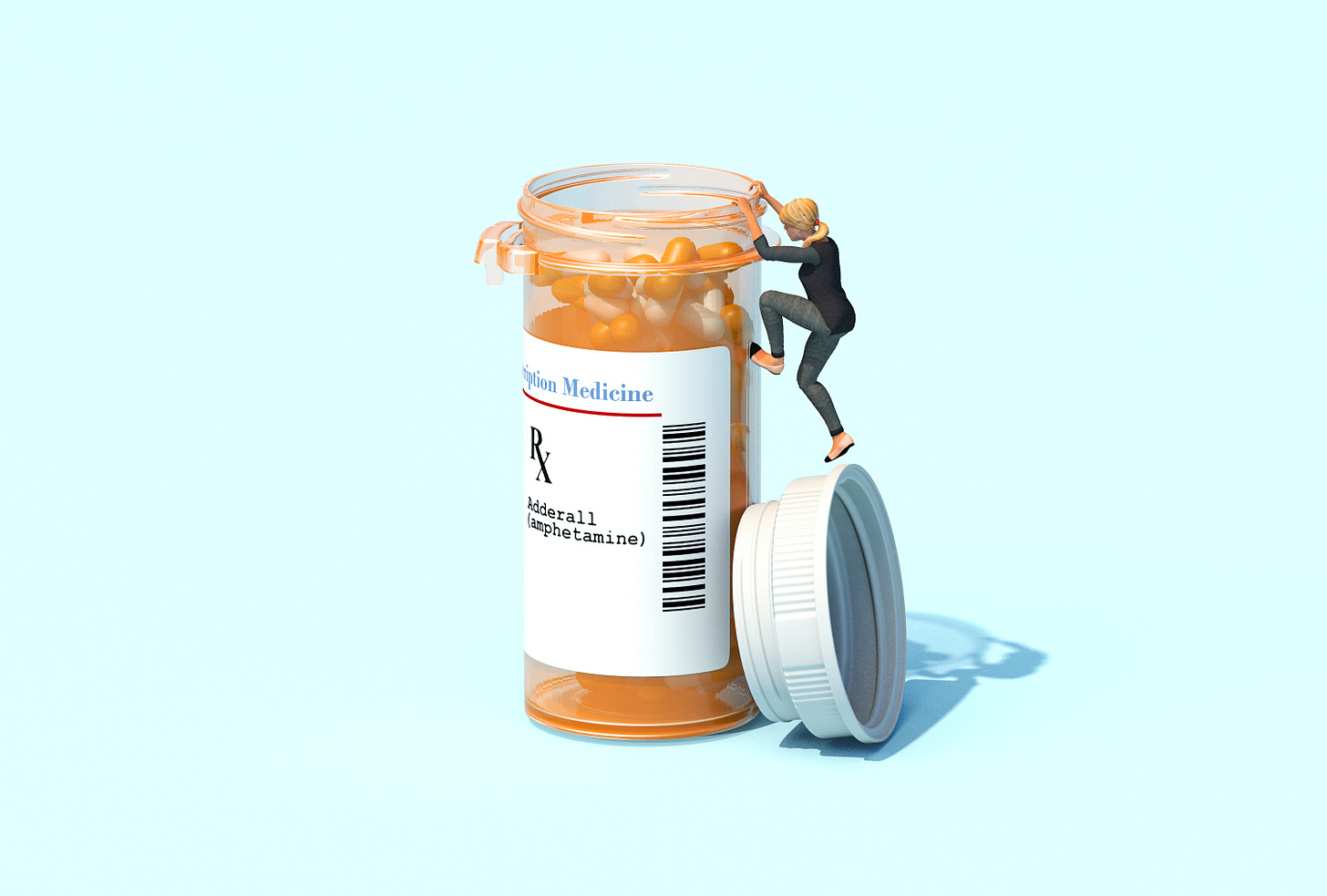
The Adderall shortage has shined a light not just on how beneficial the drug is to people who need it but also—as per the FDA advisory—how many people are misusing their prescriptions, or are getting the drug illicitly. I spoke to six people who described their struggles with Adderall addiction. Almost all started out with a quick diagnosis of ADHD and a prescription for Adderall at a young age, without an attempt to find a non-pharmaceutical solution to their problems.
Sloan Tate is a 35-year-old spiritual coach from Memphis who was put on the drug at age seven. She remembers herself as a first-grader with sporadic emotional outbursts who struggled to sit still at her classroom desk. A crisis was reached after the birth of her sister, when her mother was overwhelmed. The family pediatrician suggested medicating Sloan.
She, like the others I talked to, were told they would need to take the medication every day for the rest of their lives. (Dr. Goodman says that about 60 to 90 percent of children properly diagnosed with ADHD will continue to have symptoms into adulthood.)
“As a kid, I felt like there was something wrong with me. I always wondered how other kids were experiencing life with a normal brain,” said Sloan.
The people I talked to describe childhoods in which they struggled with a variety of mental health diagnoses, such as anxiety so severe that some went to the ER for panic attacks. Eating disorders were common. Some had a hard time making friends. Others described a feeling of emotional flatness.
Each maintained their childhood prescriptions throughout high school and college, and into their professional lives. Each had a wake-up call that prompted them to get off the drug. For Sloan Tate, it was realizing she lacked the emotional capacity to mourn when her grandmother died. Alex Cosec, a 32-year-old guitar player, real estate photographer, and fitness coach from Minneapolis, told me he decided to join Narcotics Anonymous after his ex-girlfriend called the cops on him when he took too much Adderall, among other substances, and began throwing things in their apartment.
“I’m the Adderall addict,” Cat Marnell told me. She has a claim to the title. At one point she was taking 120 milligrams of Adderall a day (60 milligrams is a high prescription dose). She wrote a book about it. She’s been in rehab for Adderall five times. Marnell was prescribed Adderall at 19 after being on Ritalin for most of her life. Adderall was different for Marnell. “Adderall was much more of a narcotic experience, and so at age 19 that was very appealing to me to be flying high from it. And that very swiftly turned into sleepless nights, dependency, obsession, a celebration of it. I was absolutely in love with Adderall,” she told me.
At the height of her addiction, Marnell got friendly with her many pharmacists, who let her know when their Adderall shipments arrived. “The shortage wouldn’t have bothered me. I knew so many tricks,” said Marnell, who added that she is now off Adderall and has been sober since November.
Dr. Lisa Weyandt is the director of the Interdisciplinary Neuroscience Program at the University of Rhode Island, where she studies ADHD, interventions for it, and misuse of drugs to treat it. She has also researched Adderall use by college students who do not have ADHD, but who regularly obtain the drug without prescription as a study aid. These young people rate their academic performance highly while on Adderall. But Weyandt says, “We found that not only did it not improve their reading comprehension, or their problem-solving, or their executive function skills, we found that it impairs their short-term memory.”
Weyandt says we need more research on Adderall misuse “to better understand the motivations and effective interventions”—research she’d like to conduct. But she says the pharmaceutical companies have no incentive to fund it, and the federal government has turned down her grant proposals.
Amphetamines were first synthesized in 1887, but the drug didn’t appear on the U.S. market until the 1930s, under the name Benzedrine. “Bennies” or “pep pills” became widely popular for their ability to elevate mood and energy and suppress appetite. By the 1950s, the downside of amphetamines—particularly the likelihood of getting addicted to the chemical high—led to the drug requiring a prescription. It was first observed in the 1930s that Benzedrine, while being a stimulant, helped children with a condition then called “hyperkinetic disease,” in which they couldn’t sit still, had trouble paying attention in school, and were generally disruptive.
It turns out that people with what is now called ADHD tend to have low levels of dopamine—a neurotransmitter that provides a sense of motivation and reward. Those lacking sufficient dopamine tend to compensate by constantly searching for stimulation. Amphetamines increase the release of dopamine, resulting in greater focus and less distractibility.
Dr. James Aluri, a fellow at the Johns Hopkins Department of Psychiatry and Behavioral Sciences, takes issue with the idea proposed by some that “ADHD is a purely contemporary cultural product.” He says in eighteenth-century medical literature there are descriptions of a clinical syndrome that sound just like the criteria for today’s ADHD diagnosis. “That’s a helpful reminder that ADHD has a biological grounding, even if diagnosis can be influenced by social factors,” he said. “There’s more to the story than the criticism that ADHD pathologizes normal childhood behavior.”
Jena Luckman, 35, a PR director in Miami, was prescribed Adderall when she was 15 years old. The move to a large high school left her feeling overwhelmed socially and physically. “I think a lot of the things they thought were part of an ADHD diagnosis were probably just symptoms of being a typical teenage girl,” she told me. She was initially prescribed 40 milligrams of Adderall, which she now sees as an irresponsible overprescription by her doctor. When she came home from college, her mother felt the drug was making Jena paranoid and angry and asked her doctor to lower the dose. He refused, saying that Jena was an adult. Instead, he prescribed Xanax for her Adderall-induced insomnia.
When the Covid-19 pandemic hit, Jena decided to take a break from Adderall for the first time since high school. The first week without it, she felt like she “had taken 100 Benadryl pills and was trying to run underwater.” After a month she went back on Adderall, but at a lower dose. Then the shortage hit, and she realized how essential the medication was for her. But she still grapples with how it has shaped her life.
Today when she takes Adderall, she gets serious, focused, robotic. She feels unable to have an emotional conversation. When she skips it for a week or two, she feels different. “I do start to see a glimpse of myself and my real personality. I’m so much more fun and cool, and I think the first step in moving towards that is probably coming off the Adderall.”
Columbia student James Hilton feels differently. For now, he’s resorted to taking a two-hour train ride to his hometown pharmacy in Connecticut to obtain Adderall, where the shortage doesn’t seem to have struck quite as severely as it has in New York.
“On the train ride, I’m usually in dire need of Adderall,” he says. “A lot of the ride is just me stressfully thinking about the tasks I need to do without the executive function to initiate them.
“Plenty of people take medications for various illnesses, and if Adderall is the one I have to take, then that’s okay,” he adds. “I’m on this earth for a short time and I should take pills that are prescribed to me to make my life as best as it can be. I hate the idea of being reliant and totally at the will of this pill, but I hate the symptoms of ADHD.”
CORRECTION: A previous version of this story misstated that Cat Marnell is currently taking Vyvanse. She says she has been sober since November.
Maya Sulkin writes for The Free Press. Follow her on Twitter at @SulkinMaya. And read Olivia Reingold’s piece about the rise in “backdoor Ozempic” here.
And to support more investigations into America’s dependence on Big Pharma, become a Free Press subscriber today:


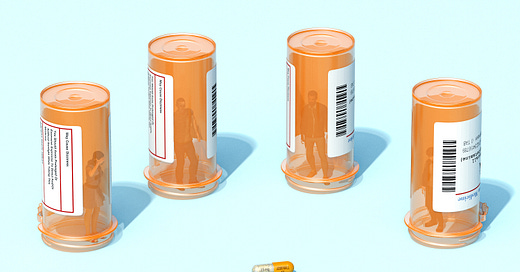






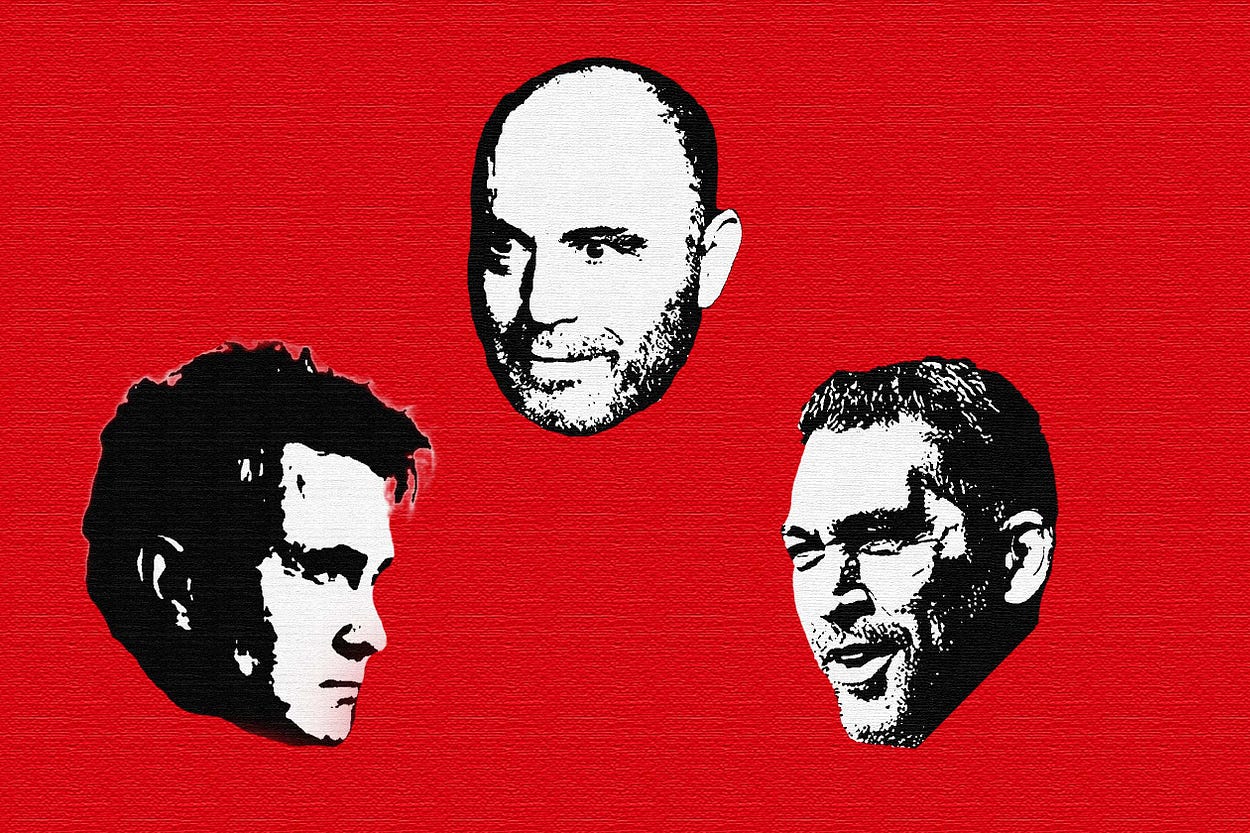

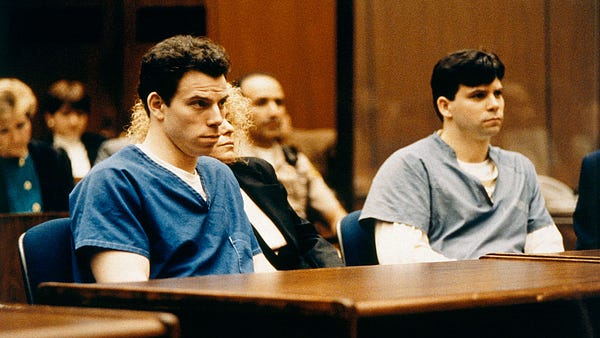

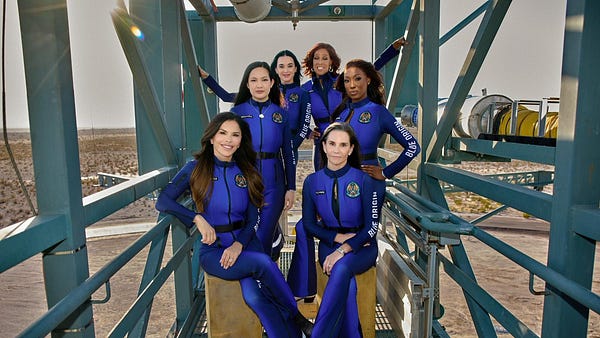





I was linked here from the "Raising Awareness" piece by SW. I read a biography of Hunter S. Thompson and he got hooked on Speed from a physician friend because it genuinely helped focus on work. I'm convinced that doctors took speed in the 1960s "like coffee" and Dr Gonzo did his best work that way.
Now we've optimized productivity and stigmatized anyone who can't do intense mental homework for 14 hours a day. Thinking does take energy and exercise. Taking doctor prescribed Speed cause your doctor used it to finish medical school has consequences.
So much of this story is reflected in the addiction of my friends son. He has tried to help keep his son out of trouble, but there always seems to be a way to get more Adderall and send him spiraling out of control.
I hope the right people can put this genie back in the bottle.